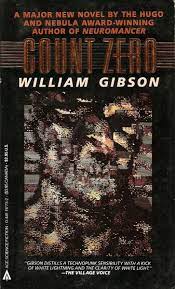How does Count Zero, William Gibson‘s second novel, hold up more than 35 years after its publication? That’s what I was thinking about, re-reading the book for the first time in at least a decade.
At the end of Neuromancer, Gibson’s first, genre-defining novel, something happened to the AIs and the entirety of cyberspace, something ineffable, something more gestured at than defined, but something that is implied to be transcendent. Count Zero begins seven or eight years after Neuromancer, according to oblique references about halfway through the book. Most of what Gibson is up to in Count Zero is oblique, an early trademark that continues into his current work.
Count Zero tells three stories, only weaving them together very late in the novel. First up is Turner, a hypercompetent mercenary of ruthless corporate espionage and warfare. He starts the novel getting put back together after being blown nearly to bits in the first paragraph, a typically dense Gibson alloy of tech, geography, neologism and action:
They set a slamhound on Turner’s trail in New Delhi, slotted it to his pheromones and the color of his hair. It caught up with him on a street called Chandni Chauk and came screaming for his rented BMW through a forest of bare brown legs and pedicab tires. Its core was a kilogram of recrystallized hexogene and flaked TNT. (p. 1)
Turner is close to Case in Neuromancer, a classic noir protagonist, a driven operator out to do his job and in search of the edge.
Marly’s manipulative ex-boyfriend got her into an art-world scandalette, hoodwinking her into trying to pass a forgery along to a more prominent gallerist. She’s putting her life back together as she enters Count Zero, sleeping on a female friend’s couch, wondering where any money will come from. A job interview with Herr Virek, a renowned collector, turns out to be much, much more than she bargained for. Virek is looking for the artist behind some unusual found-object sculpture collages. He has wealth beyond Marly’s comprehension, and he is prepared to pay handsomely for her intuition. One problem is that the path to the artist runs through her ex.
Bobby Newmark, who wants very badly to make a mark somewhere in cyberspace, has adopted the nickname Count Zero in hope that it will make him sound like a real cowboy of the net. The problem is that on his first real run — with some software from a low-level street dealer — he nearly gets killed by the kinds of countermeasures that exist in Gibson’s cyberspace. He’s sixteen seconds toward being dead as a doornail when “something leaned in, vastness unutterable, from beyond the most distant edge of anything he’d ever known or imagined, and touched him.” (p. 18)
What is the grace that has saved Bobby? And why? A lot of people want to know.
Turner’s job is to help a high-ranking scientist defect from one global corporation to another, in a world where that is more dangerous than leaving the KGB for the CIA was when Gibson wrote the book. Turner has plans and resources and failsafes, precision hardware, experienced medics, plenty of firepower. And of course it all goes sideways. Was it a setup? And why? Not too many want to know, but Turner is one of them and counts for more than most.
Underneath the thriller plot and behind all of the hard-boiled tech jargon, Count Zero is a story of encounters with the transcendent. How do powers beyond the human interact with regular people? How do people deal with thrones and seraphim — under different names, to be sure — when there is definite evidence that they are real? How might someone attempt to transcend their mortal existence? Gibson’s story gives several examples of approaching these questions, but, smartly, does not attempt to provide definitive answers.
I was impressed by how exactly Gibson portrayed Marly’s gaslighting ex-boyfriend, and what it took for her to get his emotional hooks out. The coldness, too, with which Virek’s people provided nemesis: “Give him all the money he asks for. It will likely destroy him.” Bobby’s learning process, and the layers of history within the story. He calls his near-death “pulling a wilson,” and later on meets a character who knew the original Wilson. One of the great cowboys from a decade ago claims to have found God in cyberspace; many think he’s crazy now, but with encounters like Bobby’s, can anyone say for sure?
Another motif that shows up in other Gibson novels is rural Appalachia as a place of origin and retreat. After things have gone sideways on Turner, he winds up at his brother Rudy’s in an unspecified mountain location that context indicates is likely in Tennessee. It’s very much like an early version of the county setting in The Peripheral and Agency. Turner and his unlikely charge leave there for the Sprawl — the great Boston-to-Atlanta megalopolis of Gibson’s early work — and Count Zero‘s strands finally start to come together.
How does it hold up after all this time? Splendidly, I thought. It’s dense and compact, clocking in at just under 250 pages. The threads belong together from the beginning, even though it is not obvious to readers until much later, and to some of the characters not at all. The characters do change the world, but the world of the novel does not revolve around them; their effects seem almost accidental. In fact, there’s a good argument to be made that the real story of Count Zero is not the three that Gibson presents but one that arises between them, and particularly concerning Turner’s unlikely charge. Thirty-five years on Count Zero remains strange and spiky, hard-bitten and humanistic, troubling and transcendent.

